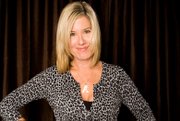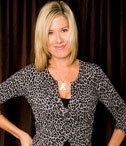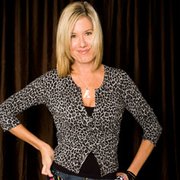Anna Kenney at Otis: Being a Designer Requires Giving 120 Percent
Anna Kenney, director of design and operations for swim and surfwear label Hot Tuna International, chalks up much of her success to the incredible mentors who guided her along the way.
There was Laurie Allyn, one-time head designer for swimwear maker Apparel Ventures, where Kenney landed a job fresh out of school as an assistant designer. When Allyn left Apparel Ventures to work as vice president of design at Catalina swimwear, Kenney went with her.
There was Dick Baker, former president of Ocean Pacific Apparel Corp., who gave her lots of responsibility. She oversaw the designs created by 13 OP licensees. “When you have mentors like that who believe in you, it helps,” she said.
Kenney shared her years of experience on Aug. 27 with a group of fashion students at the Otis College of Art and Design, which holds classes at the California Market Center as well as at its principal campus on Lincoln Boulevard near Los Angeles International Airport.
Kenney was participating in a 15-week series in which apparel-industry veterans talk about their career highlights—good and bad—at a manufacturing class taught by Rob Valerio, head of Heyy LLC, the U.S. distributor of Finnish streetwear line Ctrl, and Sheri Mobley, head of Mobley Marketing Communications. The series gives students first-hand knowledge of the career steps that shaped various fashion designers and apparel executives.For Kenney, her 17 years in the industry have always been filled with work after studying at Harbor College Los Angeles and El Camino College in Torrance, Calif.
Kenney has worked for various Southern California swimwear companies, from Authentic Fitness (now Speedo USA) to Lunada Bay, a decades-old swimwear company in Anaheim, Calif., that designs for swimwear labels such as Mossimo, Betsey Johnson, Catalina and Anne Cole.
The designer recalled that one of her most exciting moments was when one of her swimsuits designed for Catalina’s juniors label, Sunset Beach, appeared on the cover of the then recently launched Victoria’s Secret catalog. A photo of the catalog then appeared on the cover of USA Today. “It was a million-dollar suit for Catalina,” Kenney recalled.
The difficult part was re-creating that suit for several more seasons to keep its success alive. “We changed the shape of the stars to look hand-painted,” she remembered. “We changed the color of the background of the print and changed the silhouette. And honestly, nothing worked. We couldn’t do it again. Sometimes you have to move on.”
Being a designer has taken Kenney all over the world, now that manufacturing is a global business. Swimwear was one of the last categories to source outside the United States, but many are manufacturing in Mexico, South America, China or other Asian countries. “You are never off the clock,” she said, noting that Hot Tuna manufactures in countries such as Peru and China, which are located in two very different time zones. “All these e-mails come flooding in at all hours.”
For a few years, Kenney was an independent contractor after leaving OP. It was challenging working with various private labels, she said. Everyone has a different need and different ideas. It helps, she noted, to know your customer well. “It’s fun to have a relationship with a buyer and create the line with them.”
She recalls presenting her designs to a Macy’s swimwear buyer. “The Macy’s buyer hated it,” she said. “Then I found out she came from men’s gloves to women’s swimwear.”
Kenney was working as a contractor with Hot Tuna when she landed her full-time position eight months ago.
Students were eager for tips on getting that first internship or job. Kenney advised them to study up on the company, its history, products and retail outlets when applying for a position.
“I am impressed with someone who knows about the product and our competition and who is enthusiastic,” she said. Having a good portfolio to show is another key factor.
The work, she warned, can be challenging and time-consuming. Every apparel category has its high season and low season, meaning there are long days and then there is time for vacation.But in the end, it is all worth it. “There are tear-jerking times to this day for me,” she said. “You really have to put 120 percent into this industry to make it. But I love it.”

























